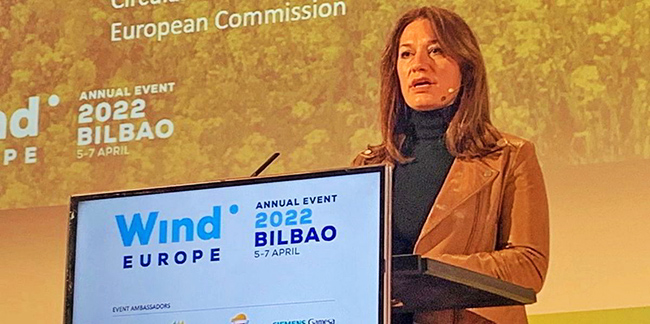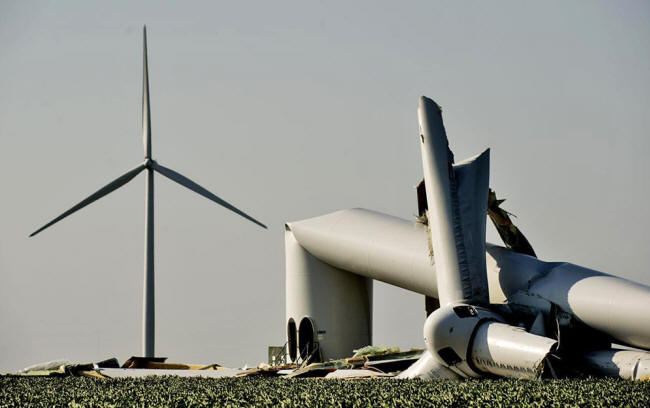Wind Turbine Makers selling at a Loss and
in a...
'Self-destructive Loop'
-
Bosses admit... -
by Bernd
Radowitz
April
05, 2022
from
ReCharge Website

Sheri
Hickok
Raw material and logistics inflation coupled with downward price
pressures from auctions have led to an unsustainable situation
where wind
OEMs are selling at a loss,
with the sector unable to deliver Europe's planned tripling of
wind capacity by 2030, industry leaders have warned.
"The state of the
supply chain is ultimately unhealthy right now," GE
Renewable Energy chief executive for onshore wind, Sheri
Hickok, told a panel at the
WindEurope 2022 conference
in Bilbao on Tuesday.
"It is unhealthy because we have an inflationary market that
is beyond what anybody anticipated even last year. Steel is
going up three times."
Steel for offshore
wind towers is currently being purchased at over $2,000 per
tonne, Hickok gave as example, adding that the prices of copper,
carbon and logistics had also soared.
"It is really
ridiculous to think how we can sustain a supply chain in a
growing industry with these kind of pressures."
After hefty price
hikes last year in the wake of the
Covid-19
'pandemic' "things were higher but stabilizing," Hickok said,
but added that with Russia's war
in Ukraine, the entire system
had "unhinched" again in the past eight weeks, making it
unsustainable at an unprecedented level of uncertainty.
The GE executive said she is very fearful for the entire wind
industry ecosystem.
"Right now,
different suppliers within the industry are reducing their
footprint, they are reducing jobs in Europe," she explained.
"If the government thinks that on a dime, this supply chain
is going to be able to turn around and meet two to three
times the demand, it is not reasonable."
The European
Commission's recent
REPowerEU plan, formulated in
response to Russia's invasion of Ukraine, wants wind
power capacity to soar from 190GW today to 480GW by 2030.
Destructive loop
Nordex chief executive
José Luis Blanco stressed that even before the Ukraine war,
the economics in the wind industry had been destroyed due to
price pressures from competitive tenders coupled with a low
visibility of wind capacity pipelines due to failed government
policies.
"We are still
selling at loss, because of the dynamic of auctions, the low
predictability of volumes," Blanco told the conference.
"We are investing in volumes in trust in market dynamics,
then the volume doesn't come, then a factory is empty, [and
then] it is better [to have] some cash flow than no cash
flow - and [consequently] the sector enters into a
self-destructive loop."
Blanco also said if
Europe wants to triple its wind power capacity, it needs to
better support the independence of the supply chain.
Currently, some 85% of the industry's components are, however,
coming from China, he said.
"The energy
independence is supported by a supply-chain dependency
policy. This a huge risk."
Blanco was not only
referring to rare earths, but said "normal things" such as
metallic shafts in turbines, 95% of which are sourced in China.
All
onshore OEMs in trouble
Enercon's new chief
executive Jürgen Zeschky went even further, saying,
"all European
onshore OEMs are in trouble."
Over the past eight
years, cost was the only driver for developments, with low
levelised costs of energy and low turbine prices driving the
whole business, he told WindEurope 2022.
"We have reached
a low cost base, but at the price of outsourcing to low-cost
countries," Zeschky admitted.
"If you look at Europe and Germany, we are constantly losing
jobs in industry by relocating to other places."
But the situation has
changed fundamentally, he pointed out.
Due to Russia's war in Ukraine,
"we are faced
with a situation, where it is not only about cost, but about
an independent, resilient and reliable energy situation in
Europe".
To have sustainable
energy generation, Europe needs a sustainable industry, and thus
has to overcome being constricted to the lowest cost, he
explained.
"That needs to
change."



